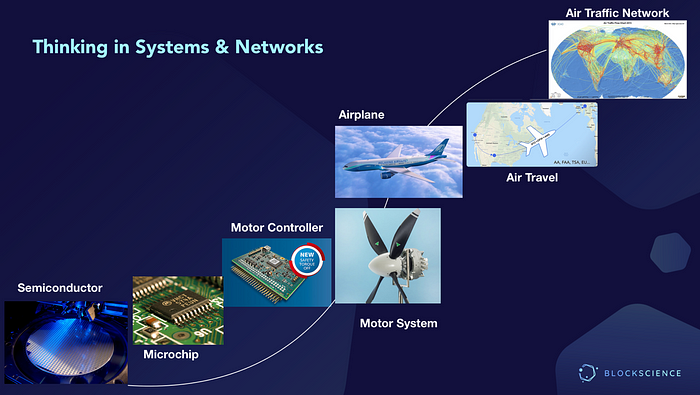Charles Rice with Michael Zargham
Now that the bloom is off the cryptocurrency rose, we can start to take a look at the long-term opportunities arising from blockchain technology. And the reality is that there is far more there than a cryptographically secure medium of exchange.
Blockchain will become as essential to our lives as the semiconductor.
Few people know the history of that revolutionary little device, beyond giving the name to Silicon Valley, but semiconductors are a transformative technology. They underpin electronics design, enabling the creation of micro-controllers that are necessary for smarter, more reliable mechanical systems like motors.
The picture below (Figure 1) offers an example of the iterations we mean. Better mechanical systems enabled applications like jet engines and airplanes, which in turn power the travel and freight systems of our modern air traffic network.
Even a century ago, the technological capacity to travel around the world in just hours was still science fiction. Yet today it’s taken for granted that someone can board a plane in the evening in New York and be in London by sunrise. And all of it derived from successive iterations on a base technology.
With the flexibility of software development and the cryptographic data security blockchain provides, it appears that we can design and realize anything from assured, secured real-world supply chains to complex economic ecosystems.
It’s the second opportunity — the chance to bring whole economies into being, complete with their uncertainties and complexities — that interests us here.
In the rest of this article, part one of a series, we will describe a new discipline called ‘token engineering,’ that is emerging to serve the new economy.
In part two, we will discuss what token engineers actually do and describe our general methods and practices.
And in part three, the most technical of our series, we will dive deeper into both the mathematical foundations of this emerging field and the tools that the team at BlockScience has built to help make the overall process rigorous and responsible.
Part I: Token Engineering from Zero to One
Right now, token engineering is an emerging field. (The term only came into use with Trent McConaghy’s March 2018 article “Towards a Practice of Token Engineering”.) We can summarize it as a discipline focused on the design of the self-organizing systems enabled through cryptographic peer-to-peer networks.
Open source projects like Hyperledger, Ethereum, IPFS, MakerDao, and Sovrin have created an unprecedented opportunity to blend theory with practice¹ and design, create, and observe real economic ecosystems in real time.
The open networks built on blockchain exist for the same purpose as their analog counterpart: to meet some human need or desire. Software engineering and development in the form of smart contracts and distributed applications fill the role occupied by brokers or go-betweens in personal networks.
Perhaps most importantly, economic networks built on blockchain are independent of any single person or institution. While the network cannot be controlled by one entity, it also cannot be fixed and repaired by a single entity. This means that such a network must be designed and realized to be resilient to the shocks of human life.
In a natural network, the mechanisms and institutions of exchange like barter, cash, and credit evolved over centuries. Their resilience is the result of lifetimes of trial and error. In purpose-built networks we have the opportunity to design and implement these mechanisms from the very beginning. It falls to the token engineer to handle the operational intelligence of the ecosystem, to ensure that incentives align, and to maintain the network’s equilibrium and independence.
Given the scope of the challenge, it should not be surprising that the talent stack for this emerging field is difficult, if not impossible, to describe exhaustively. At BlockScience, we have PhDs in Systems Engineering, Economics, and Anthropology; professional engineers of every stripe; and data scientists all working to build the tools that can design and assure the performance of these digital mechanisms. Take a look at figure 2 to get a clearer picture of the diversity of expertise and specialties that go into this field.
Ours is by no means the only practical mix of talents, skills, and knowledge working on these problems. In my experience, the most important real prerequisite to token engineering is a hunger to understand how things work and a willingness to explore both theory and data with my favorite time tested, community-driven protocol: Science.
In this article I have tried to provide a high-level overview of the blockchain opportunity beyond cryptocurrency, to describe in broad strokes the need for a new field of token engineering, and to list out just some of the skills and expertise that go into it. In my next few installments, I’ll go deeper into the engineering — the processes, methods, and considerations that we think about when building new social, technical and economic ecosystems.
¹ For more on the dichotomy of ‘speaking with theorists’ and ‘whispering in the ears of princes’, see Alvin Roth, “Laboratory Experimentation in Economics”


